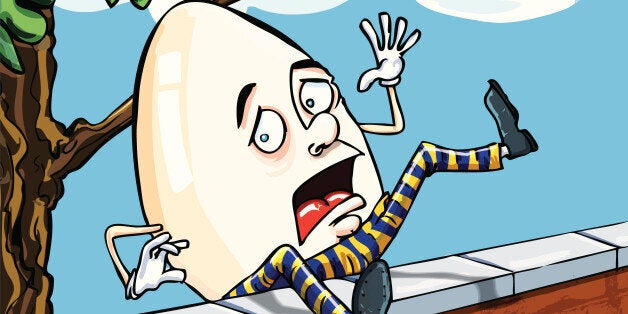
Nursery Rhymes - bit of innocent fun to entertain the little ones on a rainy day, right?
Wrong.
Those seemingly-innocuous verses that every child who grew up in the UK knows off by heart are anything but. Your little angels are actually spouting tales of murder, crime and torture of the most unimaginable agony.
Let us enlighten you... (full explainers can be found at the end).
Humpty Dumpty
In the summer of 1648 during the English Civil War, a Parliamentary force laid siege to Colchester in which a Royalist army was positioned. The Royalists employed a large cannon on a wall next to St Mary's Church. The wall was damaged causing the cannon to fall off. The Royalists tried to reposition the cannon but "all the King's horses and all the King's men, couldn't put Humpty together again".
Ring a Ring a Roses
A rather unpleasant way to die in 1665 was by a hefty dose of bubonic plague. A quarter of the population of London at the time - 100,000 people - died. One of the most visible symptoms is swollen lymph nodes which produces a rosy red rash in a ring around the swelling. Eventually gangrene can set in and without treatment coma and death can swiftly follow.
Jack and Jill
King Charles I was rather peeved when his attempt to reform taxes on liquid measures was blocked by Parliament. Undeterred he craftily set about reducing the size of measures instead, thereby effectively increasing tax by volume. Half a pint used to be called a "Jack" and a quarter pint a "Gill/Jill". So when "Jack fell down and broke his crown", "Jill came tumbling after".
Baa Baa Black Sheep
Think taxes are high these days? They're nothing compared to feudal-era England. Tax on wool meant one-third went to the nobility, one-third to the Church, leaving the last remaining third for the farmers. And that little boy down the lane? Nada.
London Bridge is Falling Down
A number of cultures around the world at one time or another believed a sacrifice of a human child should be incorporated into the foundations of a building or it will collapse. In Japan it was called "Hitobashira". To date however, no evidence of a sacrifice has been found around where London Bridge once stood.
Mary, Mary Quite Contrary
As well as being a popular hangover cure, Bloody Mary also refers to the rather vicious Mary I of England. One theory about the rhyme states that the "growing garden" actually refers to cemeteries she was filling with Protestants she had tortured and killed. Silverbells is a colloquial term for thumbscrews and cockleshells were instruments of torture that attached to the genitals. Ouch.
Three Blind Mice
This rhyme could be Mary I of England again. The three blind mice are said to be three Protestant nobleman which she had burned at the stake. They weren't blind in the ocular sense but in their refusal to see the "true" version of Christianity. "The farmer's wife" is thought to be Mary and refers to her husband's great swathes of land that he owned.
Little Jack Horner
Between 1536 and 1540 Henry VIII set about the dissolution of the monasteries after he broke away from the Catholic Church. In an attempt to save himself the Bishop of Glastonbury, Richard Whiting, sent his steward, Jack Horner, on a mission to bribe the king. Deeds to 12 manorial estates were hidden in a pie and sent with Horner but the mission was a failure - Whiting was hung drawn and quartered. Curiously, soon after Horner moved into one of the manors fuelling rumours he had stolen one of the deeds. His descendants however insist he paid for it fair and square.